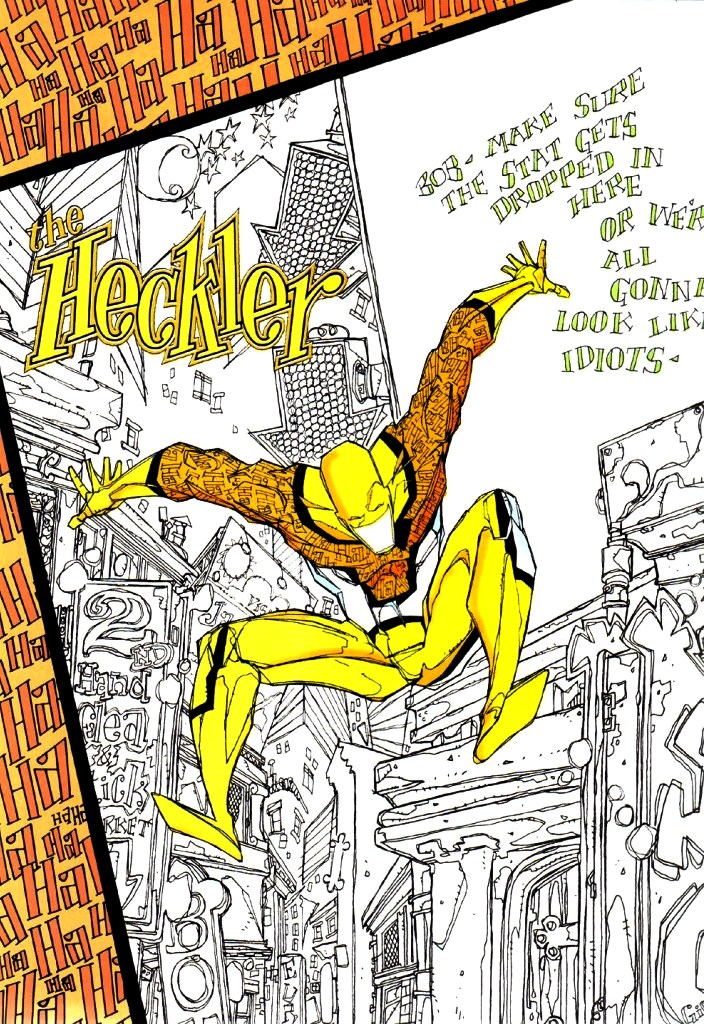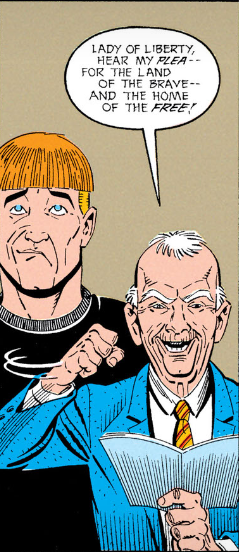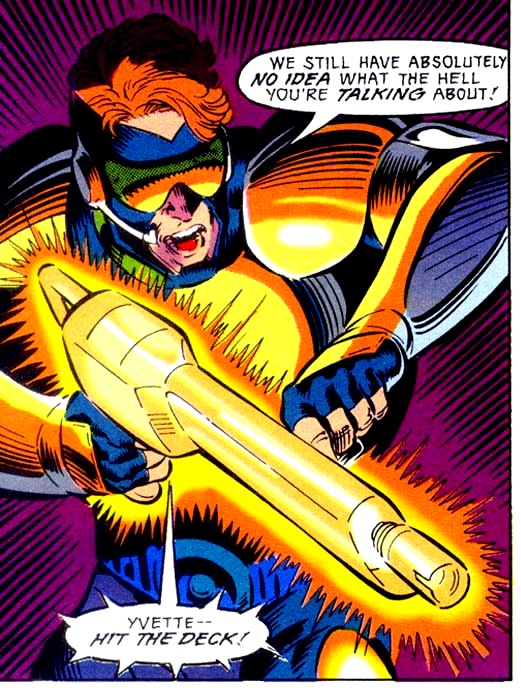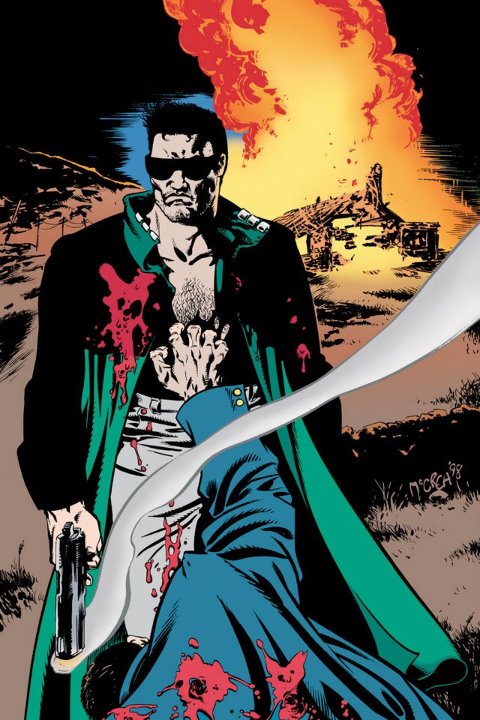Comic books changed drastically in the 1990s. There is a reason the 1990s is referred to as separate as the Bronze Age. It is a thing of its own, and there is a reason people refer to it on it’s own. It is known for its loud, brash, characters, and it had a lot of events, as well as a plethora of new characters. We will be taking a look at a few of them.
Heckler

Thought of as the “Bugs Bunny of superheroes,” Heckler was created by Keith Giffen in 1992 because Keith Giffen wanted to create a comical superhero, much like his earlier Justice League run was. Heckler donned a colorful yellow costume that had the words “Ha ha” on it. Keith Giffen created the character because he wanted to work on a comic book starring Bugs Bunny, but he thought that DC, the publisher of the current Bugs Bunny comic book, would not approve of his idea for a Bugs Bunny comic book. Tom and Mary Bierbaum, who worked with Giffen on Giffen’s run of Legion of Superheroes, scripted the series, as Giffen mostly plots and pencils. A prime example of this is his Justice League run, which he plotted, J.M. DeMatteis scripted, and Kevin Maguire worked on the pencils.
The series starred the co-owner of a diner in the fictional Delta City by the name of Stuart Moseley. Stuart just fights crime for the sheer fun of it, and has no motivations nor powers. He just dons a colorful costume and fights criminals with his bare fists. The series was not particularly popular due to the fact that humor books were not popular in the 90s, so Keith Giffen left the book and asked DC to cancel it.
General Glory

In the pages of Justice League International, J.M. DeMatteis and Keith Giffen created a new character, General Glory. He was a pastiche of Marvel’s Captain America, as J.M. DeMatteis previously worked on the character. J.M. DeMatteis created General Glory with Keith Giffen because DeMatteis had previously had an idea for a Captain America story that was turned into the story The Life and Times of Savior 28 about 3 decades later. General Glory was created as a prototype of the story that was what the story was designed as early on into the project’s life. General Glory first appeared in Justice League International #46.
General Glory gets his powers from Lady Liberty, which he gets by saying:
“Lady of Liberty, hear my plea —
For the land of the brave —
And home of the free!”
General Glory was then contacted by the United States government and worked for them as an undercover operative. The United States government published comic books about him in order to make people think General Glory was fictional. General Glory then gained a kid sidekick Ernest Earnest. After doing undercover missions for the United States government for a few years, his handler, Agent Newkirk Sharp, dumped him into the ocean and he found his way back to the United States without his memories. He later learned of this when he got his identity back.

General Glory gained his memories back after he bid on a General Glory comic book, which he lost to Guy Gardner. General Glory read the comic and said his catchphrase, which meant that General Glory transformed back into how he was in the 1940s, and he gained back his memories in the process. After this event, his former sidekick, who is now Major Ernest E. Earnest arrested him for treason. General Glory was cleared of all charges when they found out that his former handler, Agent Newkirk Sharp, framed him, and Maxwell Lord had him join the Justice League because Lord thought adding a Golden Age superhero would be good for their public image. General Glory would help the team out until he succumbed to a fatal heart attack within the pages of Justice League Quarterly #16.
Argus

Now we get to the fun part. The odd characters from the peak of the 90s superhero craze. In 1993, DC Comics started a new story arc called Bloodlines, which introduced a multitude of superheroes into the DC Universe, none of whom had lasting popularity. The first of these we will cover is Argus, who served as an inspiration for the DC military branch A.R.G.U.S. Argus was created by Mark Waid and Phil Hestor and first appeared in The Flash Annual #6 in 1993.
This version of Argus was Nick Kelly, who was an undercover agent for the FBI. He gained his powers when he was bitten by an alien, which gave him enhanced strength and agility, as well as thermal vision. On one of his early missions, he went to Keystone City, home of Wally West, the third Flash, and the two were forced to team up in order to take down a few threats. After, Argus gave Flash some knowledge of Kobra, a supervillain, and left. Argus was given his own mini-series that lasted 6 minutes. The mini-series was by Mark Wheatley, Allan Gross, and Phil Hester.
Gunfire

The next one is Gunfire, who was created by Len Wein and Steve Erwin. He first appeared in Deathstroke: the Terminator Annual #2. Gunfire is the superhero name of Andrew Van Horn, who was the son of the owner of Van Horn, a tech company. Andrew Van Horn uses company technology to create a suit of armor that he used to fight Deathstroke, who he thought killed his father. Gunfire next appears as one of the members of the New Bloods, who was a superhero group made up of superheroes who got their powers as a result of the Bloodlines event. After the group fights and kills the alien monster that created them, Gunfire goes off and discovers that his father had profiteered from weapons sales to terrorists. Gunfire goes up against one of his father’s former employees who was running a terrorist group. Gunfire quickly dispatched of this group and was not seen for a few years.
Gunfire appeared a few more times in the background during superhero group shots, but he did not have a prominent role until Final Crisis, in which the Blood Pack, which was the official name of the group of “New Bloods” that teamed up. Gunfire and the Blood Pack teamed up to chase down a criminal who killed one of their members, but they were attacked by Prometheus, who fought them and cut off Gunfire’s hands. As of now, that was the last appearance of Gunfire in comics.
Hitman

The last of these New Bloods is the longest lasting one, Tommy Monaghan, aka Hitman. He was created by Garth Ennis and John McCrea, with the former being famous for creating The Boys, which had a hit TV show based on it. The most notable thing about Hitman was the fact that he had a solo series that had 62 issues, had a one-shot with Lobo, two issues with the JLA, and issue 34 won a 1999 Eisner Award for best single issue. Hitman’s series was significantly darker than the rest in the DC Universe, but he still regularly crossed over with various DC characters, including Batman, Superman, Green Lantern, and The Joker. Hitman was the longest-running character to come out of that event, most likely due to the fact that Hitman was not dependent on the event as a character. Hitman ended his series with his death, and many characters expressed sadness at his death, including Superman, who admitted he admired Tommy’s moral courage under pressure.


